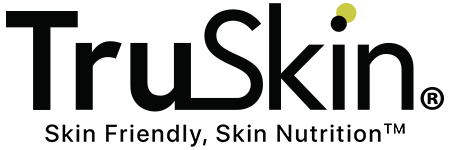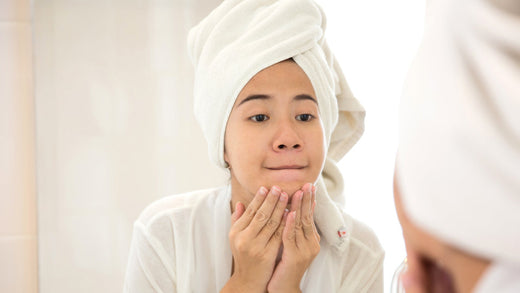
Wanna Take Control Of Acne? These Are The Ingredients To Embrace (& Avoid!)
When battling breakouts, what you put on your skin can make or break your complexion. So which ingredients can truly help acne-prone skin and which make matters worse? Let’s find out…
When it comes to the ingredients in your skincare routine it’s important to know if what you’re putting on your skin is doing any good. And if you suffer with oily, acne-prone skin, this is absolutely crucial. Because some ingredients can be a total dream for dry skin... but they're the absolute enemy of pimples and blackheads. They can block your pores, over-stimulate your sebaceous glands and cause all sorts of unwanted side-effects like redness and inflammation.
If you’re stuck in a bit of a breakout zone right now and are suspicious of your skincare routine, here’s a quick guide to some of our favorite breakout-busting skincare heroes… plus a list of some potential villains you'd be wise to avoid.
5 Of The Best Skincare Ingredients For Acne
Acne occurs when an excess of sebum becomes stuck at the surface of the skin where it chokes up your pores and combines with other debris and bacteria. It makes sense, therefore, that your skincare ingredient BFFs include those that balance sebum, increase cellular turnover and reduce inflammation.
1. Salicylic Acid
Salicylic acid is up there as one of, if not the best ingredients for reducing the severity and frequency of acne breakouts. A beta hydroxy acid (BHA), salicylic acid is what’s known as a chemical exfoliant which means it works to break down the bonds between dead skin cells so they’re able to shed more efficiently.
But it doesn’t stop there. BHAs also have another string to their bow because unlike water-soluble AHAs like glycolic and lactic acids, they’re oil-soluble which enables them to help balance your sebaceous glands to reduce excess oil and minimize breakouts. Add to that the fact that salicylic acid has anti-inflammatory and antibacterial properties and there’s very little that can beat it.
2. Tea Tree Oil
Nature also offers some incredible benefits for acne-prone skin, not least of which comes from tea tree oil.
Tea tree oil is one of the most effective oils for reducing acne breakouts because it kills certain acne-causing bacteria that sit on the surface of the skin. When that kind of bacterium gets left to its own devices, it blends with excess sebum, congests your pores and the inevitable happens lightning fast.
By treating your skin with a thoughtfully crafted tea tree oil formula (applying it neat is not advised) it will also work to calm inflammation and minimize the other visible effects of acne, namely redness and irritation. It’s kind of like the natural alternative to benzoyl peroxide – with fewer side effects.
3. Retinol
Retinol is usually thought of as the queen of aging treatments. But it’s also fabulous for fighting acne. A derivative of vitamin A, retinol helps boost collagen and increase skin turnover. It has a similar end result to exfoliation but instead of removing dead skin cells at the surface it activates specific genes at a deep cellular level, encouraging the cells to turnover quicker and more efficiently.
Cell turnover often goes awry in acne-prone skin so retinol keeps things ticking over nicely, helping to prevent blocked pores and thus reduce breakouts and minimize scarring.
4. Bakuchiol
Say hello to bakuchiol, another effective skincare ingredient from nature. Often referred to as the natural alternative to retinol, bakuchiol is extracted from the leaves and seeds of the babchi plant and has been proven to offer almost like-for-like benefits as its vitamin A counterpart.
Is it as kick-ass as retinol? Yes and no. It’s a much milder alternative, for sure, so it definitely takes a little longer to reap the same benefits as you’d get from a similar retinol-based treatment. However, its mildness means it’s much better tolerated by sensitive skin which means it's more likely to be applied consistently.
Both are fantastic in their own special ways, so our advice? Try them both (although not at the same time!) to help you decide which is best for you.
5. Niacinamide
Active ingredients can often irritate sensitive skin so it’s important to go carefully with what you put on your skin, especially during periods of breakouts when your skin is delicate and potentially inflamed.
If your skin falls into that sensitive camp, we recommend niacinamide.
A gentle giant among the skincare greats, niacinamide (vitamin B3) is extremely effective for sensitive skin that’s prone to breakouts. Not only does it help strengthen the barrier function and regulate sebum production but it also works hard to reduce inflammation and redness while aiding repair and reducing the appearance of existing scars and discolorations. Another thing: niacinamide plays well with other acne-fighting ingredients like salicylic acid making it a great way to tackle things head on without causing your skin to freak out.
3 Of The Worst Skincare Ingredients For Acne
Your biggest enemies? Harsh ingredients that dry out the skin and over-stimulate the sebaceous glands. Oh, and anything that ranks high on the comedogenicity scale. More on that to follow…
1. ‘Bad’ Alcohols
Certain alcohols like cetyl and stearyl alcohols have a rightful place in the skincare world. But many of them don’t. Low molecular alcohols like denatured alcohol (aka alcohol denat), ethanol and isopropyl alcohol, for example, are really no good – for any skin type. They can be super irritating and extremely drying on the skin which has the reverse effect on oily skin types, making the sebaceous glands produce even more oil to overcompensate for that which has been lost. When your skin produces too much sebum it clogs up your pores… and the rest is history.
2. Heavy Occlusives Like Cocoa Butter
While excellent at moisturizing, occlusives are ingredients that form a protective barrier over the surface of the skin, trapping in water and keeping dry skin moisturized. If you have oily or acne-prone skin, however, occlusives are the absolute enemy because their thick, waxy composition makes them comedogenic. This means they have the potential to plug the pores and encourage pimples as quick as a flash. Other occlusives include mineral oil, coconut oil, beeswax and lanolin. Don’t go there.
3. Sodium Lauryl Sulfate (SLS)
Have you ever been so good at something that it's seen as a disadvantage? No? Well, that’s exactly what SLS – and its buddy SLES (sodium laureth sulfate) – is. As two of the most powerful cleansers around, these sulfates clean so well that they often strip all the goodness from your skin which disrupts the skin’s protective barrier. This can leave your skin feeling squeaky clean, for sure, but also completely parched. Even irritated and inflamed. We do not advise them for skin that breaks out. The good news is, our cleansers contain neither.












